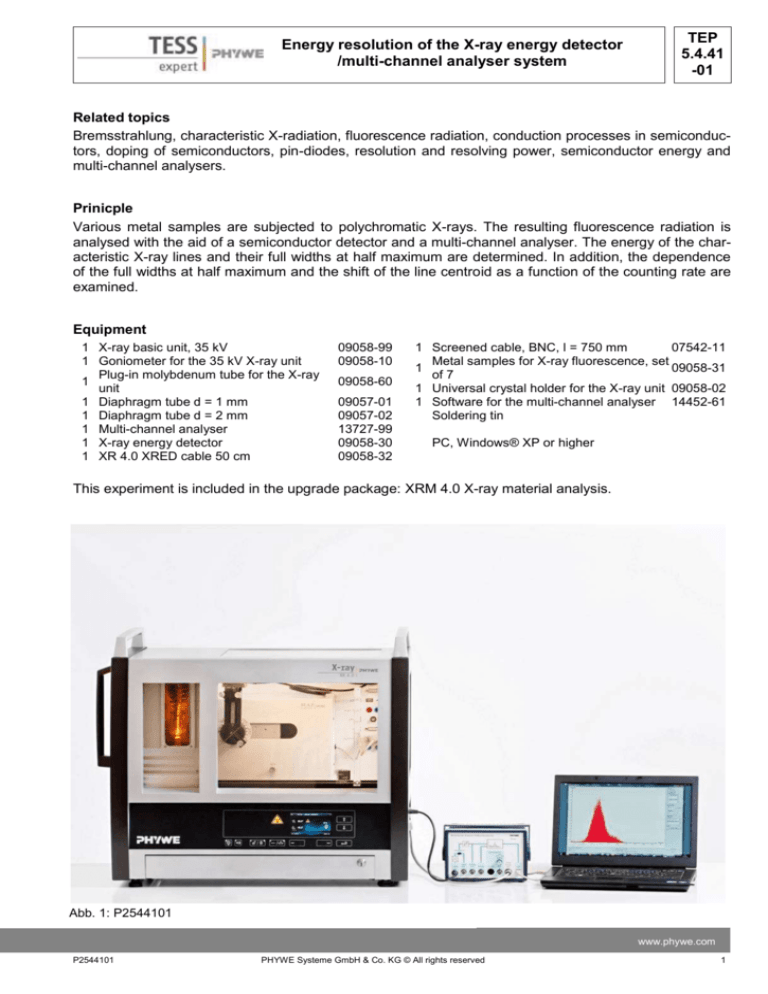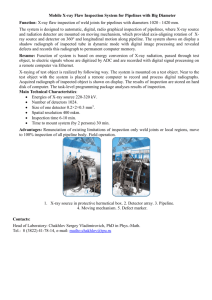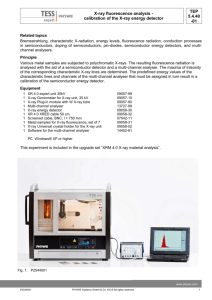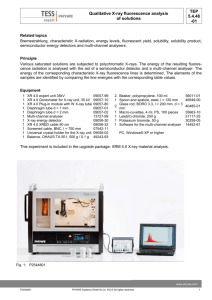
Energy resolution of the X-ray energy detector
/multi-channel analyser system
TEP
5.4.41
-01
Related topics
Bremsstrahlung, characteristic X-radiation, fluorescence radiation, conduction processes in semiconductors, doping of semiconductors, pin-diodes, resolution and resolving power, semiconductor energy and
multi-channel analysers.
Prinicple
Various metal samples are subjected to polychromatic X-rays. The resulting fluorescence radiation is
analysed with the aid of a semiconductor detector and a multi-channel analyser. The energy of the characteristic X-ray lines and their full widths at half maximum are determined. In addition, the dependence
of the full widths at half maximum and the shift of the line centroid as a function of the counting rate are
examined.
Equipment
1 X-ray basic unit, 35 kV
1 Goniometer for the 35 kV X-ray unit
Plug-in molybdenum tube for the X-ray
1
unit
1 Diaphragm tube d = 1 mm
1 Diaphragm tube d = 2 mm
1 Multi-channel analyser
1 X-ray energy detector
1 XR 4.0 XRED cable 50 cm
09058-99
09058-10
09058-60
09057-01
09057-02
13727-99
09058-30
09058-32
1 Screened cable, BNC, l = 750 mm
07542-11
Metal samples for X-ray fluorescence, set
1
09058-31
of 7
1 Universal crystal holder for the X-ray unit 09058-02
1 Software for the multi-channel analyser 14452-61
Soldering tin
PC, Windows® XP or higher
This experiment is included in the upgrade package: XRM 4.0 X-ray material analysis.
Abb. 1: P2544101
www.phywe.com
P2544101
PHYWE Systeme GmbH & Co. KG © All rights reserved
1
TEP
5.4.41
-01
Energy resolution of the X-ray energy detector
/multi-channel analyser system
Tasks
1. Calibrate the semiconductor detector with the
aid of the characteristic radiation of the molybdenum X-ray tube.
2. Determine the energy levels and full widths at
half maximum of the characteristic Kα-lines of
the different metals and represent them graphically.
3. Determination and graphical representation of
the full widths at half maximum as a function of
the counting rate, with the Kα-line of zircon used
as an example.
4. Determination and graphical representation of
the shift of the line centroid as a function of the
counting rate, with the Kα-line of zircon used as
an example.
Fig. 2: Connections in the experimentation area
Set-up and prodecure
Set-up
- Screw the adapter ring onto the inlet tube of the
energy detector.
- Connect the signal and supply cables to the corresponding ports of the detector with the aid of
the right-angle plugs.
- Connect the signal and supply cables from the
MCA to the appropriate connections in the experiment chamber of the X-ray unit (signal cable: red, supply cable: green (see Fig. 2)).
- Connect the external ports for the X RED of the
x-ray unit (signal cable red, supply cable green,
see Fig. 3) to the multi-channel analyse (MCA).
Connect the signal cable via a screened BNCcable to the “Input” port of the MCA and the
supply cable to the “X-Ray Energy Det.” port of
the MCA.
- Secure the energy detector in the holder of the
swivel arm of the goniometer. Lay the two cables with sufficient length so that the goniometer
can be swivelled freely over the entire swivelling
range.
- Connect the multi-channel analyser and computer with the aid of the USB cable.
- Insert the tube with the 2-mm-aperture.
- Bring the goniometer block and the detector to
their respective end positions on the left. Bring
the detector to the 90° position in the 2:1 coupling mode (Fig. 4).
Fig. 3: Connection at the external panel of the XR 4.0 X-ray expert unit to the MCA
X-ray energy
detector
Left position of the
goniometer
Universal crystal
holder with metal
sample
Fig. 4: Set-up at the goniometer
2
PHYWE Systeme GmbH & Co. KG © All rights reserved
P2544101
Energy resolution of the X-ray energy detector
/multi-channel analyser system
TEP
5.4.41
-01
Calibration of the multi-channel analyser
(if there is no other already existing calibration that
can be used)
- Bring the goniometer block and the detector
to their respective end positions on the
right.
- Insert the tube with the 1mm-aperture into
the exit tube of the X-ray tube.
- With the X-ray unit switched on and the
door locked, bring the detector to the 0° position. Then, shift the detector by some
tenths degree out of the zero position in or- Fig. 5: calibration of the multi-channel analyser
der to reduce the total rate.
- Operating data of the tungsten X-ray tube:
Select an anode voltage UA = 25 kV and an anode current IA = 0.02 mA and confirm these values
by pressing the “Enter” button.
- Switch on the X-radiation
- In the MEASURE program, select “Multi channel analyser” under “Gauge”. Then, select “Settings
and calibration”. After the “Calibrate” button has been clicked, a spectrum can be measured. The
counting rate should be < 300 c/s. Energy calibration settings: - 2-point calibration, - Unit = keV,
Gain = 2 – Set the offset so that low-energy noise signals will be suppressed (usually a few per
cent are sufficient), See Fig 5.
- Measuring time: 5 minutes. Use the timer of the X-ray unit.
- Make the two coloured calibration lines congruent with the line centres of the two characteristic
X-ray lines. The corresponding energy values (see e.g. P2544701) E(L3M5/L3M4) = 8,41keV and
E(L2N4) = 9,69 keV are entered into the corresponding fields, depending on the colour. (Note:
Since a separation of the lines L3M5 and L3M4 Lines is not possible, the mean value of both lines
is entered as the energy of the line).
- Name and save the calibration.
Spectrum recording
- Bring the goniometer block and the detector to their respective end positions on the left. Bring the detector to the 90° position in the 2:1 coupling mode.
- Insert the metal sample with the universal crystal holder (sample at 45°).
- Operating data of the molybdenum X-ray tube: anode voltage Ua = 35 kV
1. Concerning task 1 and 2: Measurement of the full widths at half maximum as a function of energy.
Only the corresponding Kα-lines will be evaluated.
-
Insert the tube with the 2-mm-aperture.
Adjust the anode current so that the counting rate is approximately 100 c/s.
Select the gain factor 4 (switch to gain factor 2 for the measurements of the silver and zinc samples).
Measuring time: 5 minutes for each sample (use the timer of the X-ray unit).
2. Concerning task 4 and 5: Measurement of the full width at half maximum and determination of the shift
of the line centroid as a function of the counting rate.
Only the zinc sample is used for this measurement and only its corresponding Kα-line will be evaluated.
-
Insert the tube with the 5-mm-aperature.
www.phywe.com
P2544101
PHYWE Systeme GmbH & Co. KG © All rights reserved
3
TEP
5.4.41
-01
-
Energy resolution of the X-ray energy detector
/multi-channel analyser system
Select the gain factor 4.
Adjust the required counting rate via the anode current.
Measuring time: between 1 and 5 minutes, depending on the counting rate.
Evaluation of the measurement curves
- In order to determine the line energy, switch from the bar display to the curve display. To do so, click
“Display options” and then “Interpolation and straight lines”.
- Extend the relevant line section with the aid of the zoom function
.
-
Then, select the curve section with
. Open the window “Function fitting . Then, select “Scaled
normal distribution” and confirm (shown, for example, in the Fe-spectrum in Fig. 2a-2b).
-
Find the line centroid of the normal distribution with “Peak analysis”
tion “Survey”
(see Fig. 2c).
or determine it with the func-
Note
- A tin sample can be produced easily with the aid of commercially available soldering tin for electronic
applications. Simply melt a small bead of tin off the tin wire with the aid of a lighter or soldering iron
and let it drop to the floor. The small “pancake” thus produced can be used as the sample. Fluorescence lines of the alloy constituents are not taken into consideration for the evaluation.
Theory and Evaluation
Because of Heisenberg’s uncertainty principle, the energy levels of the terms of an atom are not certain.
Instead, they have a finite, though small, width, so that the natural width of an X-ray line depends on the
sum of the natural widths of the energy levels that are involved in the transition. The line widths, e.g. of
characteristic X-ray lines, which are measured with the aid of an energy analyser, are wider than the
natural line widths by several orders of magnitude. The energy resolution of a detector is particularly high
if it can represent two closely adjacent lines in a clearly separate manner. If two closely adjacent lines A
and B have the full widths at half maximum (FWHM = Full Width Half Maximum) ΔA and ΔB and if their
line centroids have the distance W (see Fig. 3), the two lines can still be represented separately if W is
approximately ≥ ΔA + ΔB. If an X-ray line of the energy level E0 is measured with the aid of an energy
detector, the resolving power of the detector is called E0 / ΔEFWHM. The reciprocal value of the quotient is
called the resolution.
The energy analysis of X-rays with the aid of a semiconductor detector is described briefly based on the
example of a Si-pindetector (p-contact - intrinsic - n-contact). Incident X-ray quanta with a sufficient level
of energy create free electrons in the Si-crystal due to the photoelectric effect. The kinetic energy of
these electrons correlates with the energy of the X-ray quanta. Apart from the phonon excitation, the
electrons also create electron-hole pairs on their way through the depletion layer of the semiconductor.
The number of these electron-hole pairs is a measure of the energy of the incident quantum. Holes and
electrons are withdrawn by voltage that is applied externally and, thereby, creates a charge pulse. The
magnitude of the charge pulse, on the other hand, is a measure of the energy of the incident X-ray quantum. The resulting pulse height spectrum will then be analysed by a multi-channel analyser. The extension of the natural X-ray line through the detector has many causes (e.g. inelastic scattering of the incident particle/quantum in the solid body prior to the photoelectric effect). Other causes are deficiencies of
the multi-channel analyser, such as noise, which affect the pulse height distribution. Therefore, the results of this experiment refer to the overall system, which comprises the detector and multi-channel analyser. If X-ray lines are analysed with a semiconductor detector, their full width at half maximum (ΔEFWHM)
depends on their energy level E0.
4
PHYWE Systeme GmbH & Co. KG © All rights reserved
P2544101
TEP
5.4.41
-01
Energy resolution of the X-ray energy detector
/multi-channel analyser system
The following applies (see appendix):
E FW HM
E
2,35 1
E0
E0
(1)
(E1 = energy for creating an electron-hole pair)
(1) leads to
E FW HM E0 bzw. EFWHM E0
2
ist.
(2)
On behalf of all the other spectra, Figure 2a shows
the fluorescence spectrum of iron.
Fig. 6a: Fluorescence spectrum of iron
Task 2: Determine the energy levels and full widths
at half maximum of the characteristic Kα-lines of
the different metals and represent them graphically.
In Figure 2b, the two characteristic Kα and Kβ lines
of the iron spectrum are zoomed and shown with a
fitted, scaled normal distribution. Figure 2c shows
the method that was used to determine the full
width at half maximum of the Kα lines.
Table 1 shows the line energies E(Kα) (column B)
of the elements that were used, and the corresponding full widths at half maximum ΔEFWHM (col- Fig. 6b: Kα- und Kβ-fluorescence lines of iron with a fitted normal distribution
umn C).
Table 1: Full width at half maximum ΔEFWHM as a
function of the line energy E(Kα)
A
Element
Fe
Ni
Cu
Zn
Zr
Mo
Ag
Sn
B
C
E(Kα) / keV
ΔEFWHM / keV
6,39
7,46
8,03
8,62
15,78
17,50
22,17
25,30
0,360
0,369
0,371
0,377
0,420
0,429
0,512
0,552
Fig. 6c: Normal distribution of the iron Kα-lines for determining the line energy and the full width at half maximum (the original measurement curve is hidden)
Figure 4 shows the corresponding course of the
function. A square dependence of the full width at
half maximum from the energy level, which could
be expected in accordance with (2), cannot be
clearly demonstrated, which is probably due to the
narrow-band energy interval (approx. 6 keV – approx. 24 keV) that is available. The regression lines
that were added show, however, that an approximate linear dependence can be assumed for small
energy intervals.
Fig. 7: Schematic representation concerning the separation of two closely adjacent lines
www.phywe.com
P2544101
PHYWE Systeme GmbH & Co. KG © All rights reserved
5
TEP
5.4.41
-01
Energy resolution of the X-ray energy detector
/multi-channel analyser system
Task 3: Determination and graphical representation
of the full widths at half maximum as a function of
the counting rate, with the Kα-line of zircon used as
an example.
The dependence of the full width at half maximum
and of the centroid of a fluorescence line on the
counting rate can be determined particularly well
with the aid of the Kα-line of zircon, since the two
characteristic Kα- and Kβ-lines are already well
separated from each other (see Fig. 5a and 5b).
Figure 6 shows the dependence of the full width at Fig. 8: Course of ΔEFWHM = f(E)
half maximum ΔEFWHM of the zircon Kα-line as a
function of the counting rate. It can be seen that the
full width at half maximum of a line grows exponentially when the counting rate increases. Small and
nearly constant full widths at half maximum can only be achieved in a small section with counting
rates of approximately < 150 c/s.
Task 4: Determination and graphical representation
of the shift of the line centroid as a function of the
counting rate, with the Kα-line of zircon used as an
example.
Fig. 9a: Fluorescence lines of zircon with a fitted normal
distribution
When the counting rate increases, the centroid of a
line also moves towards lower energy values. This
is only a slight shift, but it can be clearly measured
(see Figure 7). The results of Figure 6 and 7 show
that a good resolution of a line can only be achieved
at low counting rates. The same is true for the sufficiently precise determination of their energy level.
Fig. 9b: Normal distributions of the zircon Kα-line for determining the line energy and the full width at
half maximum (the original measurement curve
is hidden)
6
PHYWE Systeme GmbH & Co. KG © All rights reserved
P2544101
Energy resolution of the X-ray energy detector
/multi-channel analyser system
TEP
5.4.41
-01
Fig. 10: Full width at half maximum ΔEFWHM of the zircon Kα-line as a function of the counting rate
Fig. 11: Shift of the line centroid of the zircon Kα-line as a function of the counting rate
www.phywe.com
P2544101
PHYWE Systeme GmbH & Co. KG © All rights reserved
7
TEP
5.4.41
-01
Energy resolution of the X-ray energy detector
/multi-channel analyser system
Appendix
The energy E0 of an incident X-ray quantum is used up in the semiconductor for the generation of electron-hole pairs and for the excitation of phonons.
The phonon excitation is neglected for the following analysis. This neglect is permissible, since the aim is
not to determine an absolute value for the resolving power.
If Ei is the energy for producing an electron-hole pair, the average number of electron-hole pairs that are
produced during the absorption is:
n
E0
Ei
(3)
In a simplified manner, one can assume that the statistical fluctuation σ of the average number of pairs
can be represented by a normal distribution.
n
E0
Ei
(4)
(If one would also take the phonon excitation into consideration, the product E0 · F would stand in the
numerator of the radicand (F = Fano factor = 0.13 for silicon).)
The following applies to the full width at half maximum of a normal distribution:
n1 / 2 8 ln 2 2,35
E0
Ei
(5)
If one assumes that the spectral line with the energy level E0 also has a normal distribution, the following
applies analogously:
E FW HM n1 / 2
E0
2,35
E0
n
Ei
(6)
For the full width at half maximum ΔEFWHM of the line, (4) results in:
E FW HM E0 bzw. EFWHM E0
2
8
PHYWE Systeme GmbH & Co. KG © All rights reserved
(7)
P2544101






